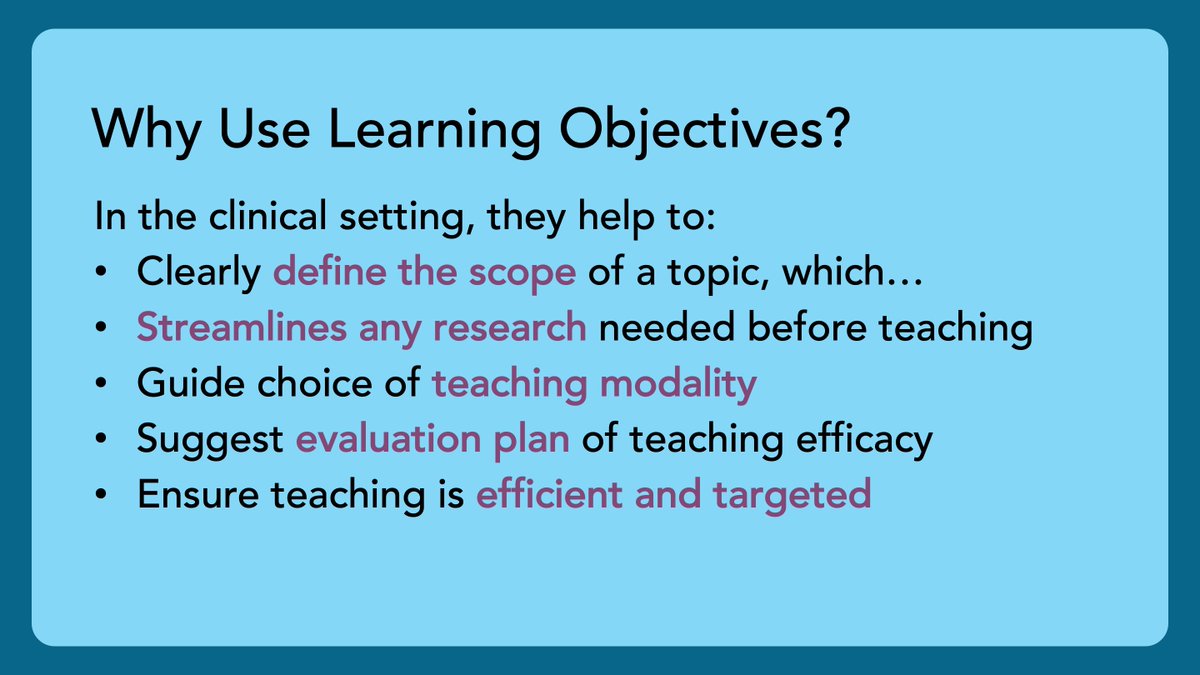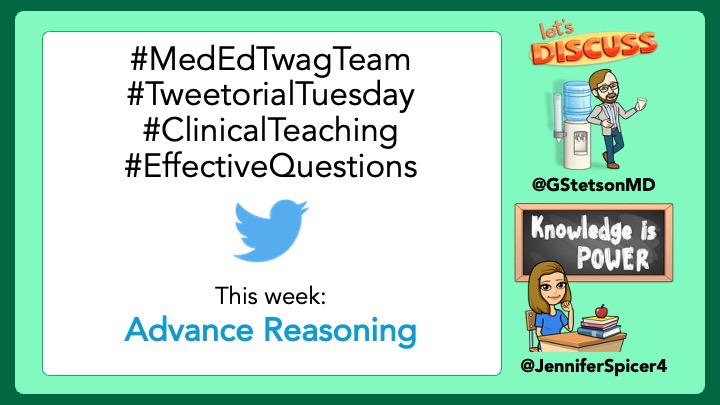
1/ Learning objectives? For serious?!? 🤔
Aren’t those for boring pre-clinical lectures?
Are they even necessary? I seem to get by just fine without them.
You may get by fine but knowing how to use learning objectives will take your game to a new level. Let's go!
Aren’t those for boring pre-clinical lectures?
Are they even necessary? I seem to get by just fine without them.
You may get by fine but knowing how to use learning objectives will take your game to a new level. Let's go!

2/ Welcome back, #MedEd and #MedTwitter friends, for another exciting week of learning from the @MedEdTwagTeam.
For orientation, we are still in our foundational skills section of #InpatientTeaching.
For orientation, we are still in our foundational skills section of #InpatientTeaching.

3/ Every resident who rotates with me leaves my team knowing why learning objectives (LOs) are important, how to make them, and how to apply them.
LOs provide structure to all didactic content, and IMHO, are the single most useful tool to power up your teaching.
LOs provide structure to all didactic content, and IMHO, are the single most useful tool to power up your teaching.
4/ Last week, my #MedEdBFF @JenniferSpicer walked us through how she figured out what she was going to teach each day. Check out her thread below, because it is 🔥, and because we will be using her examples to outline LOs.
https://twitter.com/JenniferSpicer4/status/1440369345142525960
5/ Before we jump into some examples, let’s go over:
1⃣What are LOs?
2⃣Why are they useful?
3⃣How does one create LOs?
1⃣What are LOs?
2⃣Why are they useful?
3⃣How does one create LOs?

6/ People typically think about LOs when preparing a lecture, or building an entire course. However, in the clinical setting, they are just as useful. 

7/ The outcome statement that makes up a learning objective typically takes the form of this sentence:
⭐️By the end of this [specific learning encounter], my learner should be able to [fill in the blank]…⭐️
⭐️By the end of this [specific learning encounter], my learner should be able to [fill in the blank]…⭐️
8/ And what do we use to fill in the blank? Verbs from #BloomsTaxonomy
This is something you need to get comfortable with if you are interested in #MedEd.
Here is the most popular version that is on the world-wide web, and a tabular version that is easier to read.

This is something you need to get comfortable with if you are interested in #MedEd.
Here is the most popular version that is on the world-wide web, and a tabular version that is easier to read.


9/ Here is a slide from last week that Dr. Spicer used to show her (fake) patient list and their diagnoses. One (fake) patient had MSSA bacteremia, and below is the list of potential teaching topics that she could teach on related to that diagnosis. 

10/ Let’s just take one of those potential teaching topics and use #BloomsTaxonomy to flesh it out a little bit more. Here are some example learning objectives from each level of Bloom’s.
Note: Verbs are in yellow. Bloom’s level is in parentheses.
Note: Verbs are in yellow. Bloom’s level is in parentheses.

11/ This is just 1 topic out of the 9 Dr. Spicer listed, and I was able to come up with 6 very different LOs.
And look at what happens based on which learning objective you select.
Note: In this case, evaluation refers to verifying your teaching was effective, not grading.
And look at what happens based on which learning objective you select.
Note: In this case, evaluation refers to verifying your teaching was effective, not grading.

12/ Think about this. If we made 6 LOs for each of Dr. Spicer’s 9 topics, that’s 54 teaching approaches for 1 patient!!! With 6 more to go!🤯
This shows the myriad ways to approach clinical teaching, & why LOs are VITAL to being organized & effective. Still think LOs are boring?
This shows the myriad ways to approach clinical teaching, & why LOs are VITAL to being organized & effective. Still think LOs are boring?
13/ Lastly, #BloomsTaxonomy highlights LOs in the cognitive domain. Other domains are:
✅Psychomotor – useful in procedures/surgery
✅Affective – useful in patient communication & identity formation
Affective and Psychomotor taxonomies are here:
lbcc.edu/sites/main/fil…
✅Psychomotor – useful in procedures/surgery
✅Affective – useful in patient communication & identity formation
Affective and Psychomotor taxonomies are here:
lbcc.edu/sites/main/fil…
14/ In the spirit of #BloomsTaxonomy, I would love for you to APPLY these teachings to your next clinical session.
When you have some information you want to impart, be specific about your intended takeaways. This will make your job easier, and your teaching more impactful.
When you have some information you want to impart, be specific about your intended takeaways. This will make your job easier, and your teaching more impactful.

15/ Next week, @YihanYangMD will be coming at y’all with some insights about helping trainees set shared-learning goals.
It will be a great one!
Thanks for joining this week. Tweet you next week!
It will be a great one!
Thanks for joining this week. Tweet you next week!

• • •
Missing some Tweet in this thread? You can try to
force a refresh




















